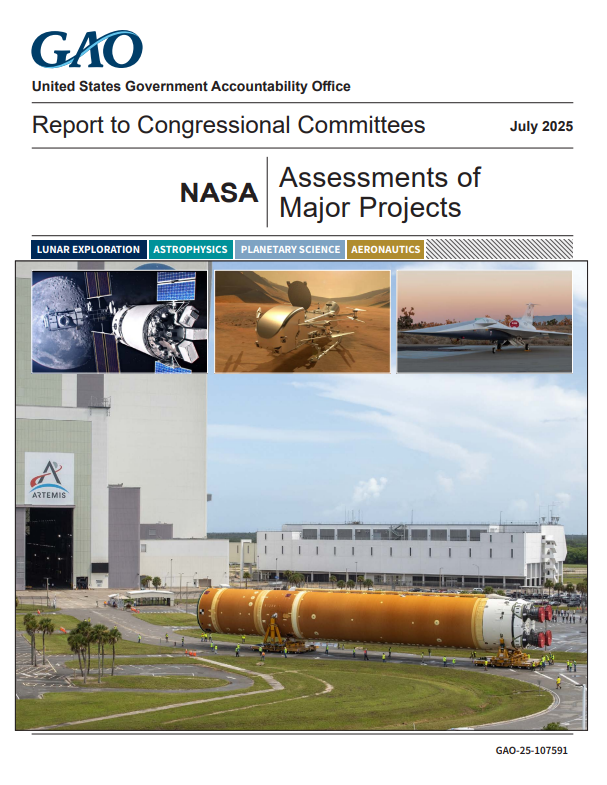
ㅇ 미국 회계감사원(GAO)은 미국 항공우주국(NASA)이 추진 중인 25개 주요 우주 프로젝트(총 예산 약 267억 달러)를 대상으로 일정과 예산, 기술 준비도 등을 종합 평가함
- GAO는 절반 이상의 NASA 프로젝트가 일정 지연을 겪고 있으며 대규모 예산 초과 사례도 지속적으로 발생하고 있다고 평가함
- 특히 10억 달러 이상의 초과 비용이 발생한 대형 프로젝트 3건에 대해서 기술 성숙도 부족과 요구사항 변경을 예산 초과의 주요 원인으로 지목함
□ 기술 미성숙과 관리 프로세스의 문제점
ㅇ GAO는 NASA가 프로젝트 착수 단계에서 기술 준비도가 충분히 성숙되지 않은 상태(TR Level 6 미만)임에도 임무를 본격화하는 경향이 있다고 분석함
- 이로 인해 개발 중 성능 기준이 변경되거나 기술 설계가 반복되어 리스크와 비용이 급격히 증가하는 문제가 반복됨
- 성능 요구사항 정의가 명확하지 않거나 불완전한 경우가 많아, 프로젝트 초기의 일정·예산 추정이 실제와 괴리를 보이며 후속 조정이 잦은 것으로 나타남
□ GAO의 권고 및 NASA의 대응 방향
ㅇ GAO는 NASA가 향후 프로젝트 관리를 개선하기 위해 다음과 같은 조치를 권고함
① 기술 성숙도 확보 기준 강화
② 요구사항 확정 시점의 명확화
③ 일정·비용 추정의 신뢰도 제고
④ 외부 독립 검토 확대
ㅇ NASA는 이에 대한 일부 권고를 수용하고 있으며, 보다 체계적인 포트폴리오 관리 시스템 도입과 함께 프로젝트 초기단계 검토 절차를 보완하려는 움직임도 보임
- 그러나 GAO는 여전히 NASA의 내부 절차가 위험을 조기에 탐지·제어하는 데 미흡하다고 지적하며 지속적인 모니터링이 필요하다고 강조함
목차
Letter 1
Background 3
NASA’s Cost and Schedule Performance for Projects in Development Remained Stable after 2 Years of Improvement 11
Most NASA Projects Avoided Significant Cost Overruns, but the Scope of Artemis Projects Could Drive Future Cost Performance 17
Agency Comments 25
Appendix I Individual Project Summaries 29
Assessments of Artemis Major Projects in the Formulation Phase 31
Infographic of Artemis Missions 33
Extravehicular Activity and Human Surface Mobility Program (EHP) – Extravehicular Activity (EVA) Development Project 35
Extravehicular Activity and Human Surface Mobility Program (EHP) – Lunar Terrain Vehicle (LTV) 37
Human Landing System (HLS) – Sustaining Lunar Development (SLD) 39
Space Launch System (SLS) Block 2 41
Assessments of Artemis Major Projects in the Implementation Phase 43
Gateway – Habitation and Logistics Outpost (HALO) 45
Gateway – Power and Propulsion Element (PPE) 47
Human Landing System (HLS) - Initial Capability 49
Mobile Launcher 2 (ML2) 51
Orion Multi-Purpose Crew Vehicle (Orion) 53
Solar Electric Propulsion (SEP) 55
Space Launch System (SLS) Block 1B 57
Assessments of Non-Artemis Major Projects in the Formulation Phase 59
Demonstration Rocket for Agile Cislunar Operations (DRACO) 61
Earth System Observatory – Surface Biology and Geology – Thermal Infrared (SBG-TIR) 63
Mars Sample Return (MSR) 65
United States Deorbit Vehicle (USDV) 67
Assessments of Non-Artemis Major Projects in the Implementation Phase 69
Commercial Crew Program (CCP) 71
Compton Spectrometer and Imager (COSI) 73
Dragonfly 75
Electrified Powertrain Flight Demonstration (EPFD) 77
Earth System Observatory (ESO) – Gravity Recovery and
Climate Experiment – Continuity (GRACE-C) 79
Interstellar Mapping and Acceleration Probe (IMAP) 81
Low Boom Flight Demonstrator (LBFD) 83
MUlti-slit Solar Explorer (MUSE) 85
Near Earth Object (NEO) Surveyor 87
NASA–Indian Space Research Organisation (ISRO) Synthetic Aperture Radar (NISAR) 89
Nancy Grace Roman Space Telescope (Roman) 91
Spectro-Photometer for the History of the Universe, Epoch of Reionization and Ices Explorer (SPHEREx) 93
Early Formulation Non-Category 1 Project Descriptions 95
Appendix II. Objectives, Scope, and Methodology 101
Appendix III. Estimated Life-Cycle Costs and Launch Dates for Major NASA Projects in Development Assessed in GAO’s 2025 Report 110
Appendix IV. Major NASA Projects and Programs in GAO’s Annual Reports from 2009 to 2025 that Completed Development 113
Appendix V. Cumulative Development Cost and Schedule Performance for NASA’s Current Portfolio of Major Projects 116
Appendix VI. Technology Readiness Levels for NASA Hardware and Software 118
Appendix VII. Comments from NASA 120
Appendix VIII. GAO Contact and Staff Acknowledgments 122
Appendix IX. Additional Source Information for Images and Figures 123
Related GAO Products 124
Tables
Table 1: Characteristics of NASA Program Replans and Rebaselines 7
Table 2: Annual Development Cost Overruns and Schedule Delays for Major NASA Projects and Programs in Development since GAO’s 2024 Assessment 11
Table 3: Life-Cycle Cost and Schedule Estimates of Artemis and Artemis-Related Major NASA Projects in Development 110
Table 4: Life-Cycle Cost and Schedule Estimates of Non–Artemis Major NASA Projects in Development 111
Table 5: Approved Rebaseline and Current Life-Cycle Cost and Schedule Estimates for Major NASA Projects 112
Table 6: Major NASA Projects and Programs Included in GAO’s Annual Reports from 2009 to 2025 That Completed Development 113
Table 7: Cumulative Development Cost and Schedule Overruns for NASA’s Current Portfolio of 18 Major Projects in Development 116
Table 8: NASA Hardware Technology Readiness Levels (TRL) 118
Table 9: NASA Software Technology Readiness Levels (TRL) 119
Figure
Figure 1: NASA’s Life Cycle for Space Flight Projects 4
Figure 2: Major NASA Projects and Programs Reviewed in GAO’s 2025 Assessment 9
Figure 3: Cumulative Development Cost Overruns for NASA’s Portfolio of Major Projects 15
Figure 4: Development Cost Outcomes for NASA Major Projects That Completed Development or Are in the Final Phase of Development Since GAO’s 2009 Annual Report 19
Figure 5: Key Factors for Cost Overruns Reported by NASA Major Projects that Reached the Statutory Threshold for Reauthorization and Rebaselining 22
Figure 6: Accumulated Cost Overruns for 53 NASA Major Projects That Completed or are in the Final Phase of Development since GAO’s First Annual Assessment in
2009 23
Figure 7: Illustration of an Example Project Assessment 30
Figure 8: Projects Included in Individual GAO Analyses and Summaries 102


